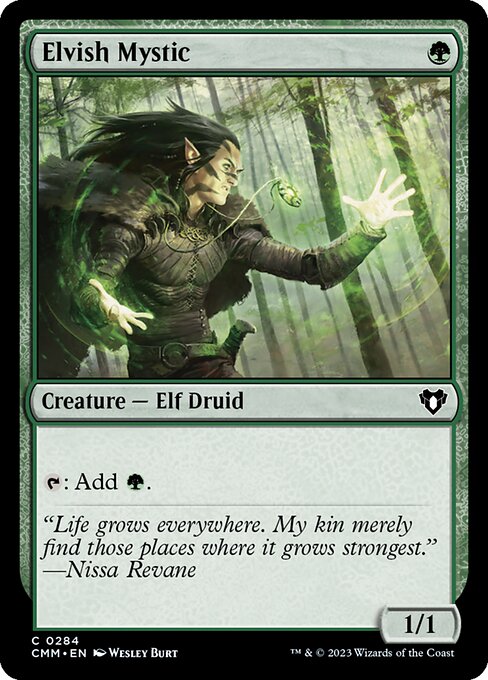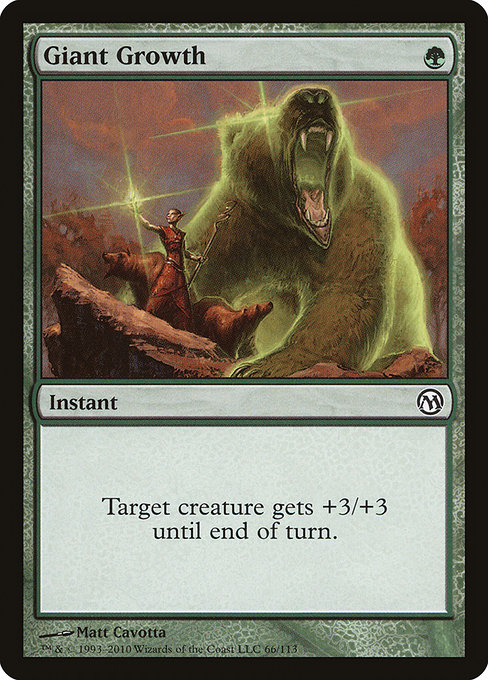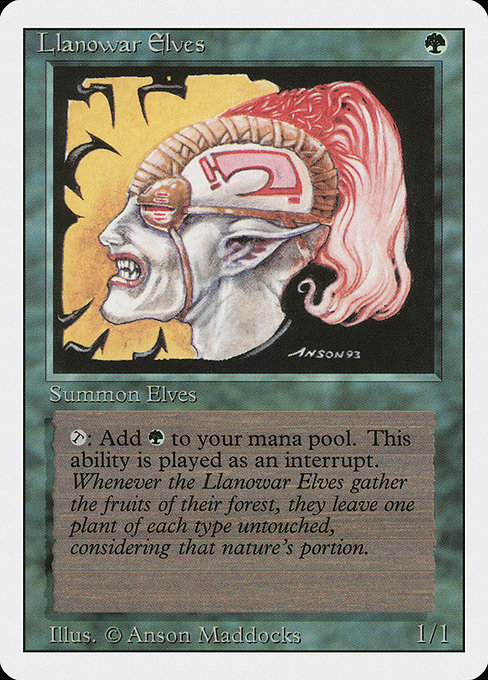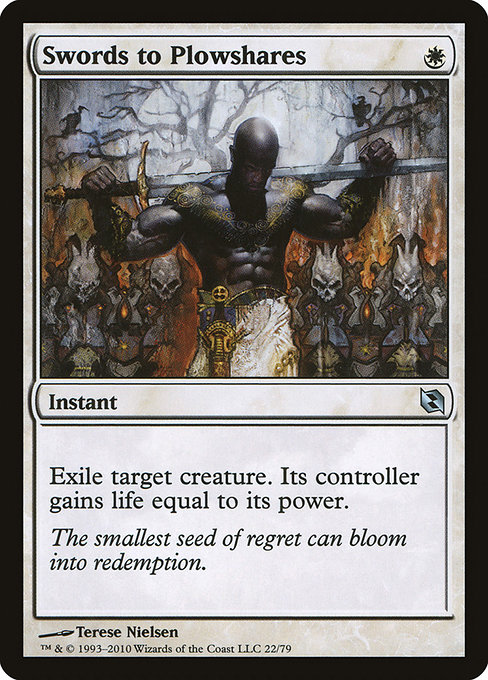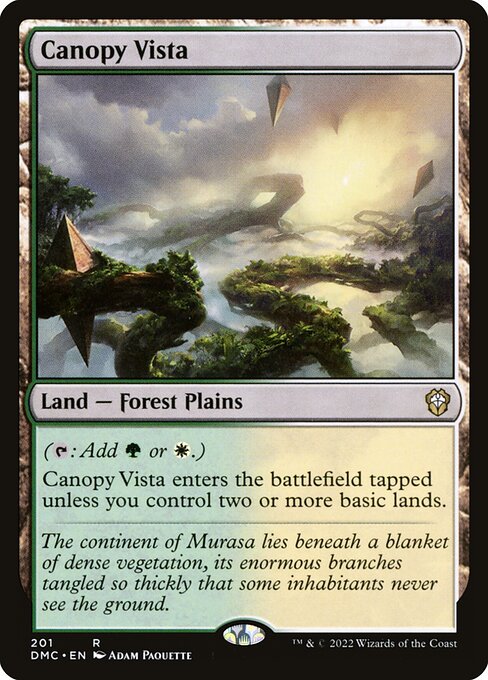
Canopy Vista

Guide Sections
Strategy Guide
Last updated 2025-07-06Quick Summary
Canopy Vista is a dual-colored land that produces either green ({G}) or white ({W}) mana. Its mana ability activates by tapping the land: "{T}: Add {G} or {W}." This means you choose whether to add green or white mana when you activate the ability, not both. The crucial element of Canopy Vista is its enters-the-battlefield effect: it enters tapped unless you control two or more basic lands. This means if you only control one basic land (or no basic lands at all) when you play Canopy Vista, it will enter the battlefield tapped, meaning you won't be able to use its mana ability until your next turn. However, if you already control two or more basic lands, Canopy Vista enters untapped, immediately providing you with mana.
This "enters tapped unless" clause is a common feature on lands designed to balance their power. It prevents the land from being too strong in the early game when mana is scarce, but still allows it to be useful in the mid-to-late game when you have more lands in play. The card interacts well with other mana-producing lands, such as Windswept Heath or Arid Mesa, which could provide the necessary basic lands to have Canopy Vista enter untapped. However, lands that don't count as basic lands, like Reflecting Pool or Command Tower, won't satisfy the condition. Importantly, the "two or more basic lands" check happens at the moment the land enters the battlefield. Any lands you subsequently play or gain control of won't retroactively affect Canopy Vista's tapped status.
Canopy Vista's strategic application hinges on its dual-color mana production and its tapped-in-hand drawback. This makes it a powerful card for decks that can quickly assemble a critical mass of basic lands, allowing them to consistently produce both green and white mana from turn two onwards.
Decks seeking to leverage Canopy Vista's abilities are primarily those utilizing a significant number of Forests and Plains. This is particularly beneficial for two-color decks running strategies like ramp and token generation. For example, Selesnya Company and other strategies relying on efficient creature deployment will appreciate the consistent mana fixing. It also helps decks that lean on powerful white and green spells that demand specific mana combinations, such as Collected Company itself or Collected Company-style strategies in formats like Pioneer or Modern.
Canopy Vista fills several crucial roles depending on the deck's construction and the metagame. Primarily, it serves as mana fixing, providing both green and white mana reliably once the early-game requirement is met. This removes the reliance on other less consistent mana fixing options such as Windswept Heath or other fetch lands, which are often far more expensive. In decks focused on ramping into larger, more expensive spells, it helps to accelerate the game plan and reach critical mana thresholds quickly.
In aggressive strategies, Canopy Vista might appear less optimal due to its tapped condition; however, in midrange strategies, its consistent mana fixing and later-game power can significantly outweigh the early drawback. Strategies that have multiple ramp creatures and lands which produce mana faster, such as Three Visits, can alleviate the early game issue. The flexibility of Canopy Vista is a critical asset for any two-color deck capable of meeting its mana base requirements.
Canopy Vista's dual-color mana production makes it a valuable addition to decks that utilize both green and white mana. Its tapped condition on entry necessitates a strategy that either floods the board early with basic lands or focuses on utilizing its abilities later in the game. This makes it particularly well-suited for midrange or control strategies rather than aggressive, fast-paced decks.
The tapped entry restriction is easily mitigated in decks running a high density of basic Forests and Plains. This synergy is key to maximizing Canopy Vista's efficiency. Consider including cards like Temple Garden or Windswept Heath to further enhance your mana base's flexibility and speed up your mana development. Furthermore, cards like Fabled Passage allow for even greater manipulation of land types to ensure you always meet the untapped entry requirement.
For synergy, consider the powerful effects of white and green's combined strengths. Collected Company can find efficient creatures that leverage both colors, such as Voice of Resurgence or Loxodon Smiter. Similarly, several planeswalkers like Nissa, Who Shakes the World and Elspeth, Sun's Champion thrive in such a mana base.
Considering the late-game potential of this land, powerful green and white spells that require significant mana investment work well. Wrath of God style board wipes followed by strong, resilient creatures will allow you to leverage Canopy Vista’s mana production effectively late into the game. Additionally, including ramp spells like Cultivate or Rampant Growth to accelerate your land drops, including Canopy Vista, can help ensure you consistently meet the untapped condition and fully utilize its benefits.
Canopy Vista's viability is heavily dependent on the format's speed and mana base requirements. In formats like Standard and Historic, where fast, consistent mana is crucial, Canopy Vista's tapped condition significantly hinders its effectiveness. Unless a deck is already heavily invested in a plentiful basic land base, the conditional tapped entrance frequently makes it a dead draw in the early game, losing value against aggressive strategies. Decks aiming for consistent two-color mana in these formats would likely prefer lands like Windswept Heath or Temple Garden, despite their higher mana cost, due to their immediate impact. Even Botanical Sanctum provides smoother mana fixing.
Commander, on the other hand, presents a more welcoming environment for Canopy Vista. Commander games often involve longer turn sequences and more ramp strategies. The two-land clause is easier to satisfy, especially considering the prevalence of multiple basic lands in most Commander decks. Furthermore, the ability to produce both white and green mana is valuable, accommodating many two-color Commander archetypes. The downside of entering tapped is less relevant in a format less reliant on explosive early-game plays. The flexibility of Canopy Vista fits well into the many varied strategies common in Commander.
Canopy Vista's impact hinges on its ability to produce both green and white mana, while accounting for its tapped entry unless certain conditions are met. Here are a few scenarios where it shines:
One impactful scenario occurs in a mid-game situation where you're playing a Collected Company deck. Assume you're on turn 4, you control a Windswept Heath and a Forest, and your hand contains a Voice of Resurgence and a Knight of Autumn. You've already played a one-mana creature earlier. Canopy Vista, while entering tapped, provides the crucial green mana for the Voice of Resurgence and still leaves white mana available for the Knight of Autumn later that turn, allowing you to play both powerful cards consecutively. Without Canopy Vista, you might be forced to choose one, or wait an entire turn.
Another scenario highlights its utility in controlling mana fixing. Let's say you're playing a white-green control deck in the late game. Your board state includes several utility creatures, like a Loxodon Smiter and a Ajani Unyielding. You have several Forests and Plains in play already, but still need that specific green or white mana to activate a key ability. Canopy Vista seamlessly integrates, providing flexible mana generation without needing to dedicate an additional land slot to solely producing green or white.
Finally, its rare status justifies its inclusion in certain decks. If your deck features significant synergy between green and white cards, even the drawback of entering tapped is offset by the streamlined mana production it facilitates. For example, if you’re trying to cast Siege Rhino on turn four in a midrange strategy while still playing several other lands already, the combination of mana colors and smooth ramping potential makes it worthwhile.
Canopy Vista, a rare land from the Dominaria United (DMC) set, represents a significant evolution in multicolor land design. Its enters-the-battlefield-tapped clause conditional on the number of basic lands controlled is a recurring mechanic, refined over many sets. This mechanic itself harkens back to earlier lands with similar restrictions, albeit less elegantly designed. Early dual lands, such as Savannah and Scrubland, were powerful but lacked the flexibility of adding two different colored mana. Later sets introduced lands with similar mana abilities like Windswept Heath and Flooded Strand, that required additional costs like life or discarding a card. Canopy Vista occupies a middle ground, providing a readily available source of green and white mana without the harsh restrictions or additional costs associated with fetch lands. This makes it particularly attractive in decks that are not relying on aggressive mana acceleration, such as many midrange and control strategies.
Reprint appearances are yet to be determined for Canopy Vista, as it is a relatively new card. However, given its strong design and potential for widespread play, future reprints in supplementary sets like Commander decks or Masters editions are a strong possibility. The success of similar lands in previous sets hints at the longevity of a card like Canopy Vista. The demand for consistent multicolor mana in various formats is considerable, and a readily accessible card like Canopy Vista will likely fill a niche for numerous decks in various constructed and even limited formats for years to come.
Canopy Vista's impact on the game has primarily been felt in its prevalence in formats where consistent access to both green and white mana is crucial. It's not a game-breaking card on its own; instead, it serves as a crucial component that allows more powerful cards to be played effectively. Its ability to synergize with various strategies, from aggressive strategies built around creatures like Collected Company to controlling decks utilizing Elspeth, Sun's Champion, has contributed to its success. Further impacting its usage is its relative ease of inclusion within deck building; it doesn't require substantial deck building shifts or compromise on other cards to make it effective. The impact of Canopy Vista's simple but effective design is subtle but demonstrably powerful.
Canopy Vista's flavor text, while absent, is effectively conveyed through its name and art. The name, "Canopy Vista," immediately evokes an image of a lush, high vantage point in a forest, blending the forest and plains biomes. The imagined art would likely depict a sun-dappled clearing high in the trees, overlooking a wide expanse of plains or farmland below – a scene fitting for a land that produces both white and green mana. This dual-biome representation aligns well with the expected thematic elements of a set focused on the intersection of nature's forces, which could be emphasized through various interactions with cards that focus on forests and plains. For example, a card that synergizes with both forest and plains like Dryad Arbor could work very well with this land, or a card that cares about having multiple basic lands like Temple Garden further supports its design.
The design of Canopy Vista is straightforward yet elegant. The tapped condition unless two or more basic lands are controlled is a common design choice for dual lands, managing the power level and preventing excessively explosive starts. This fits nicely within the rare slot, offering a powerful effect at a manageable cost. The restriction encourages players to build mana bases with multiple basic lands, subtly encouraging a more diverse and robust mana production strategy. The simple mana production – producing either green or white mana – keeps the card easy to understand and use, unlike more complex dual lands with additional costs or activation requirements. The design strikes a good balance between power and usability, offering strategic depth without being overly complicated.
The Canopy Vista's rarity and mana cost suggest it's not budget-friendly for most players. Its rare status inherently implies higher cost compared to common or uncommon lands. While its functionality is solid – producing either green or white mana – the "enters tapped" clause unless you control two or more basic lands significantly limits its early-game impact. This drawback reduces its value compared to other, readily accessible lands.
Several cheaper alternatives exist, offering comparable functionality at a lower cost. For example, Forest and Plains are readily available basic lands, providing consistent, untapped mana production. They may lack the color flexibility of Canopy Vista, but their guaranteed mana on turn one significantly offsets this for many decks. Additionally, dual lands like Windswept Heath, while more expensive than basics, offer untapped mana of two colors and are often considered superior to Canopy Vista in many competitive formats despite their higher price. For budget-minded players, focusing on a collection of basic lands is the most cost-effective solution for consistent mana production.
Canopy Vista's seemingly simple design allows for several advanced strategic applications beyond its basic mana-fixing role. Its tapped condition upon entering the battlefield presents both a challenge and an opportunity. The challenge lies in ensuring you have sufficient basic lands to mitigate this drawback; this necessitates strategic land deployment in the early game. However, this restriction also provides interesting synergies.
One clever use revolves around utilizing fetchlands like Flooded Strand or Polluted Delta. By fetching a basic land after playing Canopy Vista, you can untap it immediately, negating the inherent tempo loss. This strategy is particularly effective in decks aiming for quick mana acceleration, as you effectively bypass a turn of delayed mana production.
Furthermore, decks utilizing ramp strategies, such as those employing Rampant Growth or Three Visits, benefit significantly from Canopy Vista's dual-color production. The consistent supply of both green and white mana enables a smoother curve for powerful high-mana-cost creatures and enchantments while maintaining flexibility for various interactions.
The delayed entrance also interacts subtly with cards like Knight of Autumn or Collected Company. In a pinch, Canopy Vista can be a land you're willing to sacrifice to the abilities of these cards, potentially generating advantage by triggering their effects while also leaving a useful land in your pool after.
Finally, the tapped-in entry condition encourages incorporating other lands that enter untapped to ensure smooth mana development. Pairing Canopy Vista with cards like Windswept Heath or Botanical Sanctum allows for a balanced mana base while mitigating the inherent risk associated with its entry condition.
Common Mistakes with Canopy Vista
A frequent mistake with Canopy Vista is playing it too early. Because it enters the battlefield tapped unless you control two or more basic lands, dropping it on turn one or two often means it won't contribute to your mana pool immediately. This can significantly slow down your early-game development, especially in aggressive strategies. Waiting until you have at least two basic lands in play before playing Canopy Vista allows you to maximize its utility from the moment it hits the battlefield.
Another common misplay involves neglecting its mana fixing capabilities. Players might focus solely on its ability to produce green mana, overlooking its potential to provide white mana when needed. Remember that Canopy Vista can produce either {G} or {W}, making it a useful tool for color fixing in decks that require both colors. This is especially valuable in decks that don't run a high density of basic Forests and Plains. Failing to utilize both color options limits its effectiveness.
Finally, over-reliance on Canopy Vista as your primary source of mana fixing can be problematic. While it's a powerful dual land, it's still a tapped land that's reliant on your other lands. Reliance on Canopy Vista without a sufficient number of other basic lands can lead to mana screw, especially if you draw multiple Canopy Vistas early. Diversifying your mana base with other dual lands like Windswept Heath or basic lands is crucial to mitigate this risk and ensure consistent mana production.
Canopy Vista offers a reliable source of both green and white mana, making it a valuable addition to decks utilizing those colors. Its dual-color production makes it flexible and synergistic with various strategies. However, its tapped entrance unless you already control multiple basic lands is a significant drawback. This makes it less effective in aggressive strategies that rely on early-game mana development. Consider playing Canopy Vista in decks with strong midrange to late-game strategies, where the delayed mana production is less impactful. Decks that include other ramp such as Three Visits or Temple Garden can mitigate the tapped-in downside. It's a powerful addition to controlling or combo decks where its flexibility proves crucial in the long game, but a less desirable inclusion in strategies emphasizing quick aggressive plays.

